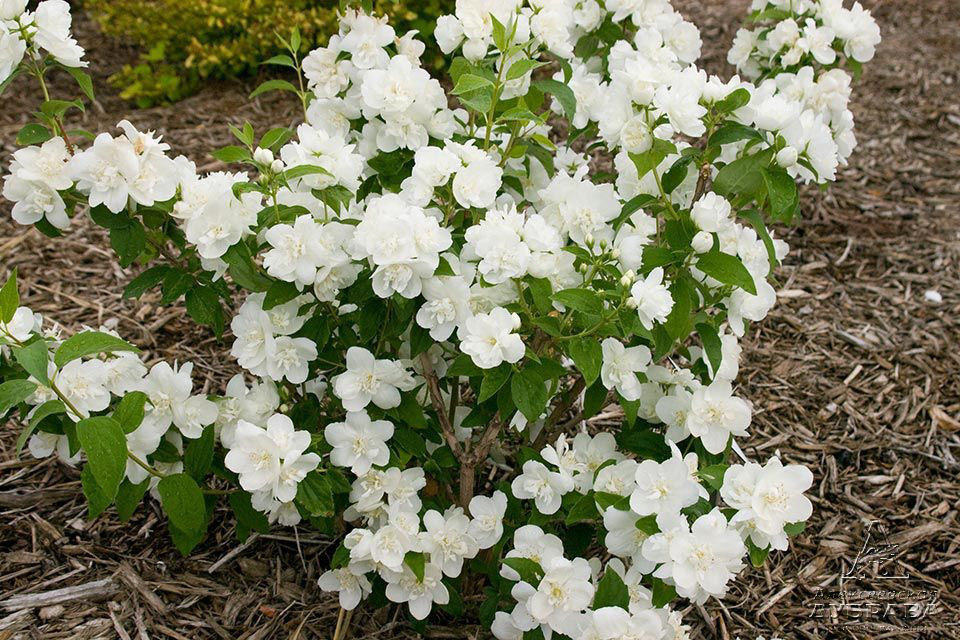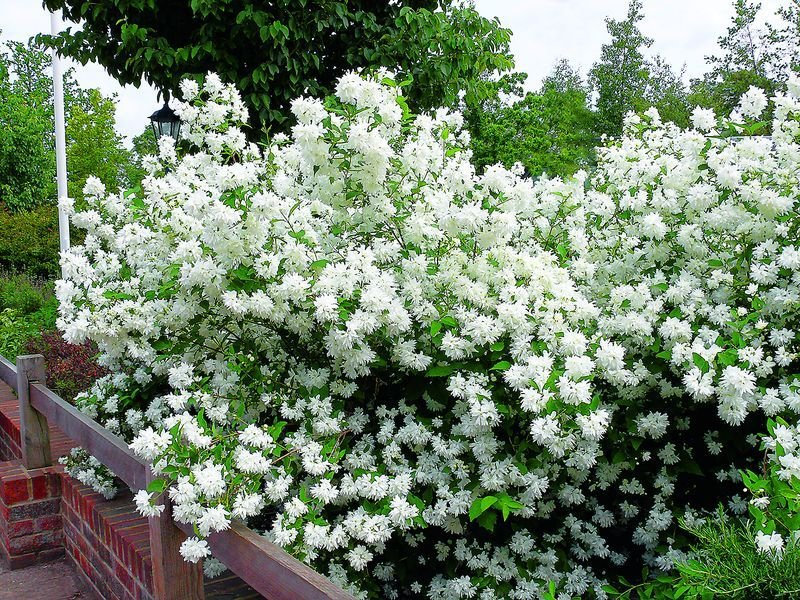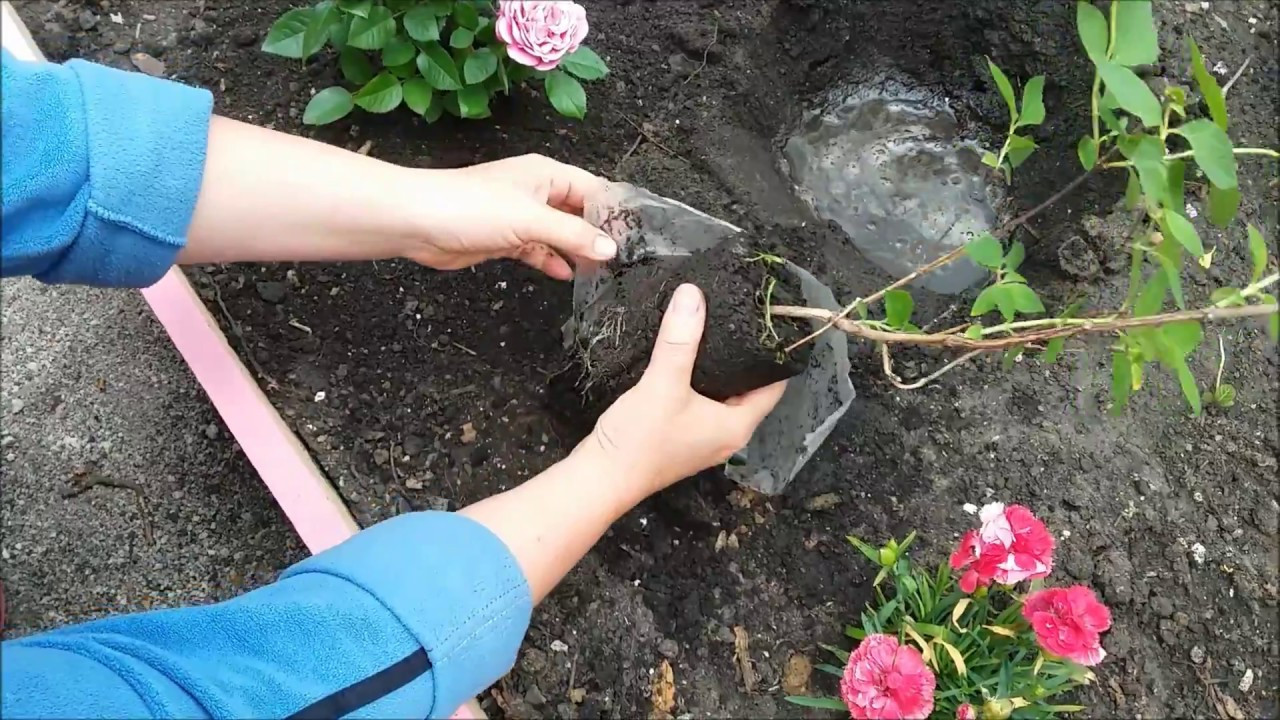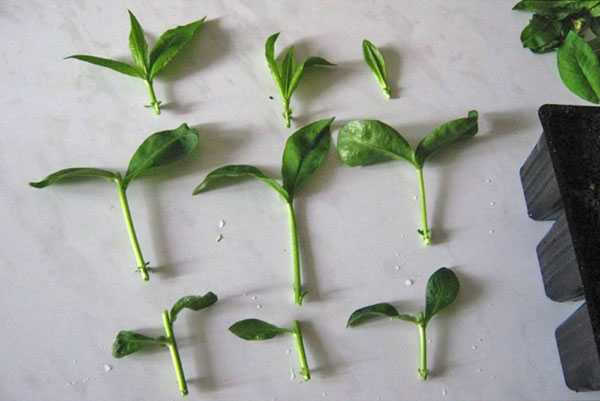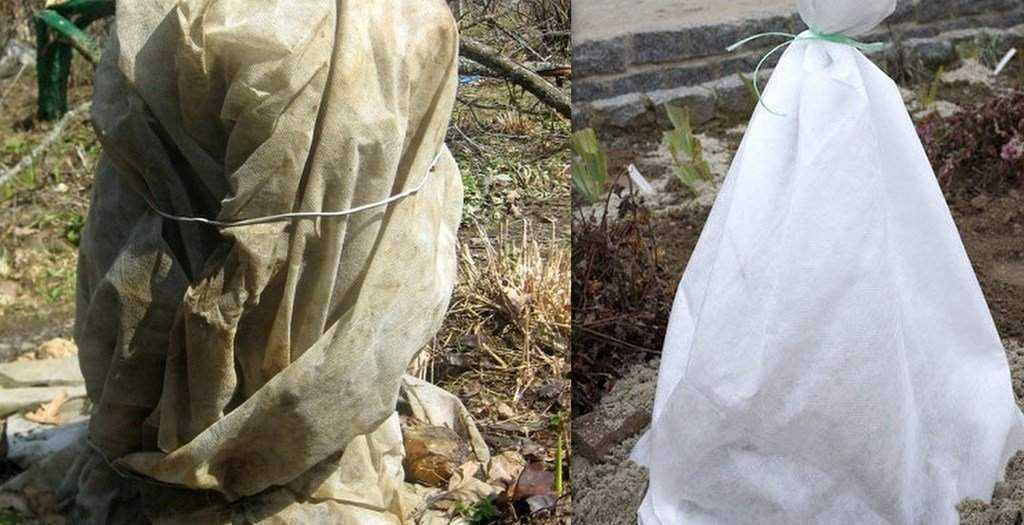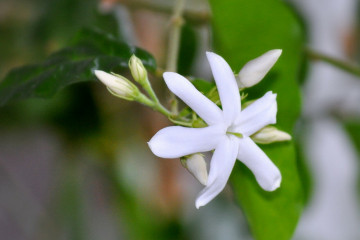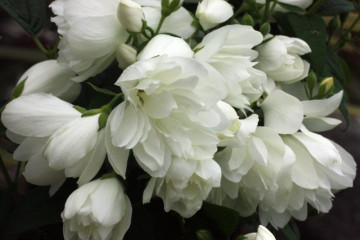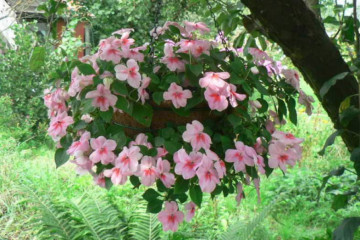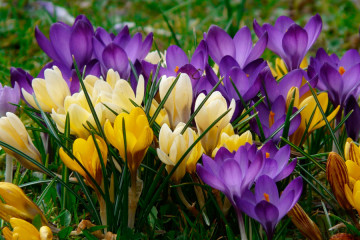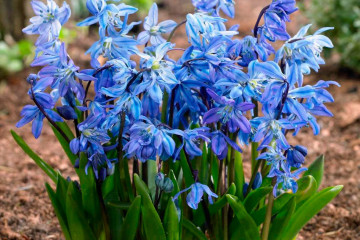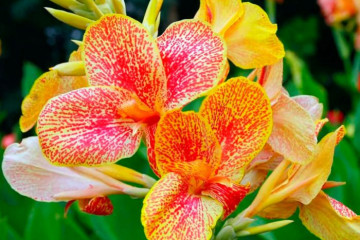Jasmine - a flower for the garden, planting and caring for a shrub
Content:
Botanists call this plant a chubushnik. Among the people, the name jasmine flower is firmly attached to the representative of the Kamnelomkovs (Hortensievs). The plant is appreciated for its delicate aroma and decorative appearance. Chubushnik bushes are found in city parks.
Cultivated by single trees in gardens and used in hedges.
Interesting about jasmine
Wild chubushnik is practically not found in Russia - it is a garden plant. Unless in the Crimea and the foothills of the Caucasus, you can stumble upon uncultivated plantings of shrub jasmine.
The plant was brought to Russia by ambassadors from Germany in the 17th century as a gift to Tsar Alexei Romanov, who was laying new gardens. The bush came to Europe from the Arab countries back in the days of paganism, when nature was of great importance to people. Jasmine flowers have attracted attention with their snow-white and pleasant aroma. Thanks to this, the plant began to be considered a symbol of innocence, pure love and was called the "tree of the bride".
With the advent of Christianity, the chubushnik did not lose its significance. From this period, it became a flower of the Virgin Mary and symbolized femininity and grace. In Asia, there is a special attitude towards this plant. It is associated with the image of the mother, revered as a sacred tree, and even called "the key to heaven."
Jasmine was named in India, linking the plant with a beautiful legend. It talks about the princess's unrequited love for the Sun God. The outcast Jasmine committed suicide, this deeply touched the soul of the deity. The Sun God raised a beautiful bush from the girl's ashes. But he endowed him with the ability to open flowers only at night, so as not to meet with the soul of the princess.
In Europe, the plant is better known as Philadelphus (from the Latin name Philadélphus). According to one version, the jasmine bush got its name in honor of the king Ptolemy Philadelphus, a zealous naturalist. The second one is based on the exact translation from Latin - "brotherly". Philadelphus loves rooting with other plants.
Garden jasmine was called a chubushnik in Russia. The hollow stems of the plant, freed from the soft core, were used to make smoking pipes (they were called shanks). They also made pipes and flutes from branches.
What does a chubushnik look like?
In gardens, only a few plant species are cultivated, which differ in a number of characteristics. There are some similar characteristics that help determine what jasmine looks like:
- it is a plant with numerous slender trunks;
- it has whole opposite leaves;
- jasmine shrub flower of the correct shape, light shades.
Among gardeners, there is a debate on the topic, jasmine is a shrub or a tree. Judging by the number of trunks, the plant can be called bushy. But the wood is dense, the chubushnik reaches a height of 3-4 meters. Therefore, many believe that jasmine is a tree.
Among the mock-mushrooms grown in Russia, 3 types are widespread, with a characteristic difference for each.
The main types of jasmine
| Name | Description |
|---|---|
| Coronary | The plant reaches a height of 3 m, but there are also dwarf forms for the garden. Produces racemose fragrant inflorescences. Creamy white flowers reach 3.5 cm in diameter.There is also double jasmine with large flowers |
| Large-flowered | Chubushnik grows up to 4 m.Snow white color forms on the lateral branches in the form of beautiful large brushes |
| Lemoine | There are dwarf and tall forms (up to 3 m in height). The racemose inflorescences are collected from large white densely double flowers more than 4 cm in diameter. There are varieties with inflorescences in the form of loose sultans half a meter long |
How the plant blooms
Jasmine is a tall, tree-like shrub. In addition to white or cream flowers, it also dissolves light golden flowers. Budding occurs in May, since June the garden is filled with a persistent fragrant fragrance.
Some wonder how jasmine blooms and when, if its petals are closed during the day. Chubushnik inflorescences wake up with the onset of darkness (when the Sun God retires). The aroma exuded by jasmine is so strong that its notes can linger in the garden until noon.
The fragrance time of the varieties may differ. For most, flowering lasts until the end of August. Only the crown chubushnik showered the petals after 20 days, having time to give an abundant color during this time.
The essential jasmine scent is actively used in perfumery to create perfumes, colognes, and deodorants. Flower teas with mock orange petals are popular all over the world due to their tonic properties.
Species and varieties grown in Russia
As soon as jasmine appeared in Russia, it immediately became a favorite plant of gardeners. Domestic and foreign breeders were actively involved in the cultivation of crops. Many varieties, despite the external difference, are adapted to the Russian climate.
Breeding by Victor Lemoine
In the middle of the 19th century, this florist made a name for himself by popularizing unusual plant species. The Lemoine family has created many varieties of decorative crops. One of the last were mock-mushrooms, distinguished by their unusual aroma.
Popular varieties of jasmine Lemoine
| Name | Features of the | Bloom |
|---|---|---|
| Mont Blanc | The bush barely reaches a meter in height. Small (up to 3 cm) snow-white semi-double flowers are collected in 3-5 pieces. into graceful inflorescences. The petals, located in the middle of the flower, are wrapped inward. The outer ones are wide, gracefully bent back, forming a dense row without gaps. | It blooms in mid-June and takes 1-1.5 months to smell. |
| Glecher | The one and a half meter shrub is distinguished by erect stems, dotted with oval foliage. Densely double large (4.5 cm in diameter) flowers, 5-7 pcs. collected in dense bundles-inflorescences up to 6 cm long. Those, in turn, are combined into huge narrow sultans (0.5-0.7 m each). | It gives color in early June and delights others with its aroma for a long time. |
| Ermine mantle | A small (0.8-1 m), almost indoor multi-stem bush stands out with narrow, small foliage and thin hanging branches. Inflorescences are abundantly formed on lateral shoots. They consist of small (2.5-3 cm) semi-double white flowers, collected in groups of 2-3 pcs. | Surpasses all other varieties in terms of flowering duration. Starting to smell sweet in the first half of June, it drops its color only in August. |
There are still many excellent varieties in the selection of Vekhov that can become a real decoration of any site.
Transplant after purchase in open ground
Seeing once a decorative bush, gardeners think about how to plant jasmine correctly so that it quickly adapts to a new place. There are no special tricks in transplanting, but some points are worth paying attention to.
Chubushnik is unpretentious in choosing a site. It can develop normally on any soil, even depleted in nutrients. The only thing that matters is that the land should not be saline.
Saplings are best purchased in nurseries where jasmine is grown in containers. Such plants can be relocated at any time.
Choosing the best place
If jasmine has no complaints about the choice of soil, then there are certain requirements for a permanent place in the plant:
- chubushnik can exist in the shade, but it will bloom profusely only in the sun;
- the plant is moisture-loving, but the degree of soil moisture should be medium; if it is high, a drainage layer is needed;
- jasmine does not like loneliness, so it is better to plant it next to other bushes.
Step-by-step planting process
Planting a seedling is a familiar event for summer residents. There are some features in the rooting of jasmine that are important in the planting algorithm:
- in the prepared area, they dig a hole 2 times more roots with an earthen lump;
- a drainage layer of 15-20 cm from crushed stone or sand is laid on the bottom;
- then fertilized soil is poured, leaving a free space from the top of the pit equal to the height of the container;
- the seedling is carefully removed from the container and placed in the center of the pit, leveling the roots;
- sprinkle them with earth, trying to keep the entire stem outside (otherwise there is a risk of decay).
The soil is compacted and a watering circle is formed, into which 2 buckets of water are introduced. Mulch is laid on top to keep the ground moist longer.
If you plan to create a hedge from jasmine, maintain a distance between the bushes of the order of 0.5-0.8 m.In group plantings, this gap can be increased by one and a half meters.
Immediately after planting, you can start forming the crown by removing weak branches and slightly shortening the main trunks. This stimulates the formation of additional kidneys.
Jasmine propagation
Chubushnik can be bred in all available ways. Someone goes the traditional and most accessible way - divides the bushes or takes layering. Others are interested in how to propagate jasmine by seeds or cut branches.
Cuttings
This breeding method is not practiced by all summer residents, considering it more laborious. Planting material is harvested in mid-June, when the plant is most intensively in development. They take non-lignified shoots and cut them into cuttings 5 cm long, trying to have 2-3 leaves on each.
Then they act according to the following algorithm:
- the container in which the stalk will grow is filled with a substrate of the same amount of sand and peat;
- the leaf plate is cut in half on the branches;
- incubate for several hours in a solution of root or heteroauxin;
- cuttings are stuck into the substrate and covered with plastic bottles.
Water it daily. Periodically open the greenhouse and spray the cuttings with a spray bottle. After rooting, the sprouts are hardened, after which they must be completely opened.
In winter, the container can be kept in the greenhouse or buried in the greenhouse. In the spring, they are transplanted into a larger container and the seedling is grown for 2 years. Only then are they transferred to open ground.
Growing from seeds
If jasmine is propagated by seeds, flowering will have to wait 5-8 years (it all depends on the variety and growing conditions). Pre-planting material is stratified and then sown before winter.
In the spring, when shoots appear, the bed is thinned out. This procedure is repeated several times throughout the season until the optimum distance between the bushes is reached. The removed sprouts can be planted in containers and kept at home.
Jasmine Garden Care
It is not difficult to take care of the mock-orange. The main thing is to comply with the basic rules of agricultural technology.
Jasmine care
| activity | Features of the |
|---|---|
| Irrigation mode | They irrigate the ground regularly, without surviving when it dries up.If the summer is hot, without rain, the procedure is carried out every decade. |
| Top dressing | They are made every year in the spring, bringing slurry under the bushes (a bucket for 1 plant). From the 3rd year of life, a complex mineral water is added with a priority to superphosphates |
| Thinning | Landings need to get rid of thickening. Therefore, 5-6 year old branches and trunks are completely removed |
Other agricultural techniques are typical for shrubs. They are performed as needed.
During flowering
When the flowers are fragrant, the jasmine needs better watering. Due to a lack of moisture, the bush will bloom earlier than usual. Therefore, in hot summer, 20-30 liters of water are added daily for each plant.
During the rest period
As soon as the chubushnik drops its color, it begins to prepare for rest. At this time, the plant is fertilized using superphosphate (20 g) mixed with wood ash (100 g) per square meter. Wilted inflorescences are immediately removed. Watering is halved and canceled completely by October.
Preparing for winter
Adult bushes can withstand cold weather. Young seedlings may not survive the harsh winter without shelter. So that the covering material is not blown off the bush by the wind, it is tied with twine. The trunk circle is dug up and weeds are removed. A dense layer of mulch is applied on top.
With proper planting and care, the jasmine shrub will delight the owners of the site with its presence for many years. Beautiful plants not only decorate the dacha, but also cheer up with a fragrant aroma.
